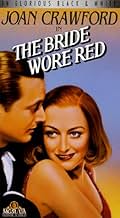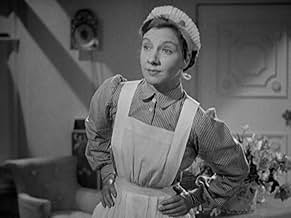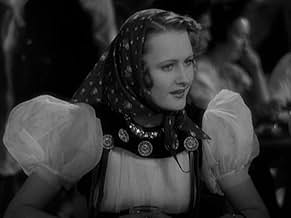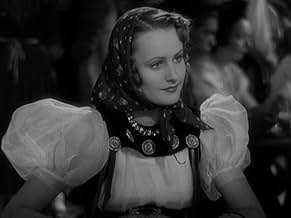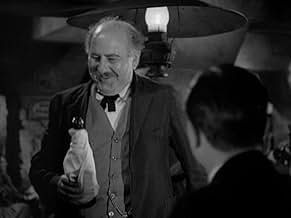IMDb RATING
6.3/10
1.3K
YOUR RATING
A lounge singer is sent by a count to pose as a wealthy socialite.A lounge singer is sent by a count to pose as a wealthy socialite.A lounge singer is sent by a count to pose as a wealthy socialite.
Mary Philips
- Maria
- (as Mary Phillips)
Rafael Alcayde
- Hotel Clerk
- (uncredited)
Nino Bellini
- Cosmos Club Waiter
- (uncredited)
Agostino Borgato
- Cordellera Bar Waiter
- (uncredited)
Adriana Caselotti
- First Peasant Girl
- (uncredited)
Robert Cauterio
- Hotel Clerk
- (uncredited)
Irene Coleman
- Cosmos Club Hat Check Girl
- (uncredited)
Gino Corrado
- Cosmos Club Croupier
- (uncredited)
Featured reviews
Joan Crawford stars in "The Bride Wore Red," a 1937 MGM film based on the play by Ferenc Molnar. Here, it's directed by Dorothy Arzner. Arzner was a fascinating woman - a female director amid a sea of men - very much ahead of her time in her dress, profession, and lifestyle, and highly intelligent. Was she a great director? Hard for me to say. I don't think she always got the best scripts. And in Crawford, she had a headstrong star as well.
The story concerns a poor girl, Anni (Crawford) who sings in a sleazy café (read: with prostitution as a sideline)in the red light district of Trieste. A count she meets believes that the only thing separating the rich from the poor is money - it's not class, it's not breeding, it's not education. To make his point, he sends Anni to a fabulous resort with beautiful new clothes for two weeks. Anni meets Rudi (Robert Young), from an excellent and wealthy family, but he's engaged. With time short, Anni decides that it's Rudi she wants, and is determined to stick it out as long as necessary to get him. But it's not only a lack of funds and Rudi's fiancé standing in her way - it's also the postman, Giulio (Franchot Tone).
Crawford is beautiful, and this was the type of role she played continuously in the 1930s with great success. Tone, Young, and Billie Burke give her good support.
What is this business with the "no European accents" that someone mentioned? Actors do not use European accents when portraying foreigners in their own country or a nearby country. The characters aren't speaking English with a foreign accent in Poland, Switzerland, or Italy. They're speaking another language. If accents were necessary, all Chekov plays would be done with Russian accents. They aren't.
I thought for what this was, the film took a little too long to make its point and was a bit slow in spots. It's not the best Crawford film, but she gives a strong performance as a willful woman determined to marry money. As for Arzner's direction, apparently she couldn't get anywhere with Crawford, so I'll withhold judgment.
The story concerns a poor girl, Anni (Crawford) who sings in a sleazy café (read: with prostitution as a sideline)in the red light district of Trieste. A count she meets believes that the only thing separating the rich from the poor is money - it's not class, it's not breeding, it's not education. To make his point, he sends Anni to a fabulous resort with beautiful new clothes for two weeks. Anni meets Rudi (Robert Young), from an excellent and wealthy family, but he's engaged. With time short, Anni decides that it's Rudi she wants, and is determined to stick it out as long as necessary to get him. But it's not only a lack of funds and Rudi's fiancé standing in her way - it's also the postman, Giulio (Franchot Tone).
Crawford is beautiful, and this was the type of role she played continuously in the 1930s with great success. Tone, Young, and Billie Burke give her good support.
What is this business with the "no European accents" that someone mentioned? Actors do not use European accents when portraying foreigners in their own country or a nearby country. The characters aren't speaking English with a foreign accent in Poland, Switzerland, or Italy. They're speaking another language. If accents were necessary, all Chekov plays would be done with Russian accents. They aren't.
I thought for what this was, the film took a little too long to make its point and was a bit slow in spots. It's not the best Crawford film, but she gives a strong performance as a willful woman determined to marry money. As for Arzner's direction, apparently she couldn't get anywhere with Crawford, so I'll withhold judgment.
I've never been a fan of Joan Crawford, so it's always a surprise to find a performance of hers that really wins me over. I liked her in Grand Hotel (as 'Flaemmchen,') and I liked her again, very much, as Anni, the cheap night-club singer masquerading as a lady. Often seen in hard and brittle roles, Crawford has a very different look in this film, and expresses a vulnerability that brings her character to life. (Billie Burke is also notable, in the small but juicy role of the acid-tongued Contessa. And Franchot Tone has never been more likable.)
The Bride Wore Red is certainly built according to studio formula, but it also embodies all the earnest craftsmanship that characterized the studio system. The film at times seems clichéd, but it fully redeems itself through genuine empathy for the characters. And through its very strong premise: a 'scarlet' woman driven by hunger for the good life, who is given a slim chance of joining the upper class - provided she's cold and deceitful enough.
Until the final act, I really felt that the film could have gone either way: warm-hearted romance or bitter tragedy. The delicate balancing act makes it hard to achieve a satisfying pay-off. But the ending does succeed, thanks to a couple of nicely orchestrated scenes, and to the talent and charisma of Ms Crawford. These do make us believe that Anni could only choose as she does.
I was a bit sorry the film didn't delve just a little deeper into the moral and social dimensions. Anni's real problem is not what she wants, but rather what she may have to give up in order to get it. That distinction is not made entirely clear, leaving the film a bit too reliant on the old cliché that 'wealth doesn't bring true happiness.' But there's more going on here. Anni's 'tragic flaw' is not the hunger itself, but her willingness to give up honesty, morality and even true love. This distinction becomes almost subliminal, but it's there, and gives the film a slightly sharper edge. Anni is a character we can identify with and possibly admire, even when she's doing something despicable.
If you're in the mood for a traditional, old-style Hollywood entertainment, you won't go wrong with The Bride Wore Red. This is one of the good ones, a film I'd gladly watch again any time.
The Bride Wore Red is certainly built according to studio formula, but it also embodies all the earnest craftsmanship that characterized the studio system. The film at times seems clichéd, but it fully redeems itself through genuine empathy for the characters. And through its very strong premise: a 'scarlet' woman driven by hunger for the good life, who is given a slim chance of joining the upper class - provided she's cold and deceitful enough.
Until the final act, I really felt that the film could have gone either way: warm-hearted romance or bitter tragedy. The delicate balancing act makes it hard to achieve a satisfying pay-off. But the ending does succeed, thanks to a couple of nicely orchestrated scenes, and to the talent and charisma of Ms Crawford. These do make us believe that Anni could only choose as she does.
I was a bit sorry the film didn't delve just a little deeper into the moral and social dimensions. Anni's real problem is not what she wants, but rather what she may have to give up in order to get it. That distinction is not made entirely clear, leaving the film a bit too reliant on the old cliché that 'wealth doesn't bring true happiness.' But there's more going on here. Anni's 'tragic flaw' is not the hunger itself, but her willingness to give up honesty, morality and even true love. This distinction becomes almost subliminal, but it's there, and gives the film a slightly sharper edge. Anni is a character we can identify with and possibly admire, even when she's doing something despicable.
If you're in the mood for a traditional, old-style Hollywood entertainment, you won't go wrong with The Bride Wore Red. This is one of the good ones, a film I'd gladly watch again any time.
Well, you can't blame Joan for trying. Always wanting to go beyond that glamorous clothes-horse/shopgirl-makes-good mold in which MGM so successfully cast her throughout the 1930's, she was always attempting to outreach her grasp. When Metro's Austrian star Luise Rainer backed out of making a film of Molnar's THE GIRL FROM TRIESTE, a dark photoplay about a prostitute sent on a masquerade in the Tyrolean Alps, Crawford grabbed it, hoping to get her teeth into a meaty role. Imagine her chagrin when Metro executives "improved" the piece to be more suitable for Crawford's image, taking the meat and guts with it. What emerged was an uncomfortable picture built on compromises in an attempt to graft a typical Crawford/Cinderella plot onto what is basically a nasty, mean little story. Registering far below the Crawford usual at the paybox, THE BRIDE WORE RED started her career to skid.
A closer look, however, reveals that not all of the edge has been softened from the piece. I wholeheartedly agree with the reviewer who calls this Joan's most underrated performance, and there is a reason we do not sympathize with this Cinderella. Crawford's Anni is cold and snappish, and has the potential to do real harm to some nice, decent folk. The film plays like the dark side of all of those rags-to-Adrian gown stories Crawford played in the Metro phase of her career, and CRAWFORD IS FULLY AWARE OF THIS. Although seemingly played straight, there is an irony underneath that tells us Crawford herself isn't crazy about Anni either. It's understandable that 1937 audiences did not warm to a Joan they couldn't root for (even her hair is cut into a severe, but stunning, pageboy), but it deserves real recognition now that we are removed from the era and have seen ALL the phases of Crawford's career. In many ways, it's a harbinger of the darker, icier roles she was to play at Warner Bros. and throughout the 1950's.
The performances are uniformly good, with George Zucco strong as the decadent, evil Machiavelli who sends Anni on her masquerade, but Crawford, for the most part, is the standout. Only in the early scenes of the film, when she attempts to portray Anni as a world-weary honky tonk singer (in what must have been the cleanest, most glamorous "dive" in all of Trieste!!) does she fail to convince.
(Ironically, Crawford's next film, MANNEQUIN, released early in 1938 and co-starring Spencer Tracy, was a strictly paint by the numbers Rags-to-Adrian tale, inferior to this, that found great favor with the movie-going public.)
A closer look, however, reveals that not all of the edge has been softened from the piece. I wholeheartedly agree with the reviewer who calls this Joan's most underrated performance, and there is a reason we do not sympathize with this Cinderella. Crawford's Anni is cold and snappish, and has the potential to do real harm to some nice, decent folk. The film plays like the dark side of all of those rags-to-Adrian gown stories Crawford played in the Metro phase of her career, and CRAWFORD IS FULLY AWARE OF THIS. Although seemingly played straight, there is an irony underneath that tells us Crawford herself isn't crazy about Anni either. It's understandable that 1937 audiences did not warm to a Joan they couldn't root for (even her hair is cut into a severe, but stunning, pageboy), but it deserves real recognition now that we are removed from the era and have seen ALL the phases of Crawford's career. In many ways, it's a harbinger of the darker, icier roles she was to play at Warner Bros. and throughout the 1950's.
The performances are uniformly good, with George Zucco strong as the decadent, evil Machiavelli who sends Anni on her masquerade, but Crawford, for the most part, is the standout. Only in the early scenes of the film, when she attempts to portray Anni as a world-weary honky tonk singer (in what must have been the cleanest, most glamorous "dive" in all of Trieste!!) does she fail to convince.
(Ironically, Crawford's next film, MANNEQUIN, released early in 1938 and co-starring Spencer Tracy, was a strictly paint by the numbers Rags-to-Adrian tale, inferior to this, that found great favor with the movie-going public.)
I had high hopes for this one. The plot sounded good. Eccentric Count Armalia (George Zucco) believes that luck of birth is all that separates the rich from the poor. To prove his point, he sets up dive singer Anni (Joan Crawford) as a fake socialite to fool his rich friends. This works but snobbish Robert Young falls for her and wants to marry her. Anni sees the chance to get out of poverty by marrying a rich guy but, at the same time, she has started to fall for poor Franchot Tone. So it becomes a question of whether Anni will choose love or money. Glossy MGM soaper with a nice cast but somehow just misses the mark. It was nice seeing George Zucco in a different kind of role. Also Billie Burke is sort of evil, which is interesting. See it for the cast or out of curiosity. You might enjoy it more than me.
Jaded club singer Anni Pavlovitch (Joan Crawford) runs into a count who devises a plan to give Anni an opportunity to swing with the swells for two weeks in a rustic Italian vacation spot in the mountains. Anni is totally seduced by the lifestyle and with time running out moves in on Maddelena Monti' s well heeled beau Rudi Pal ( Robert Young) to try an insinuate herself into the jet set lifestyle on a more permanent basis. The local postman Giullio (Franchot Tone) has also taken a shine to Anni offering her an unencumbered down to earth existence in contrast but cynical Anni is tired of the hardscrabble existence preferring pampered materialism instead.
Under the rare oddity of a female studio film director (Dorothy Arzner) Crawford is allowed to stretch with more than satisfying results as she struggles with the conflict of hooking up for love or money. Arzner not only gets some impressive long takes out of Crawford but also softens her standard studio brusqueness with a touching sensitivity as her dream of easy street evaporates before her eyes.
Arzner also gets fine performances out of upper crusts played by Young and a beautifully smug performance from Billie Burke without being condescending to such easy targets. The real surprise though is the sophisticated Franchot Tone as Giullio the country postman. Playing it neither broad or passionate Tone subversively bides his time with a dignity and patience that gives The Bride Wore Red a nice subtle edge and a more touching denouement.
Under the rare oddity of a female studio film director (Dorothy Arzner) Crawford is allowed to stretch with more than satisfying results as she struggles with the conflict of hooking up for love or money. Arzner not only gets some impressive long takes out of Crawford but also softens her standard studio brusqueness with a touching sensitivity as her dream of easy street evaporates before her eyes.
Arzner also gets fine performances out of upper crusts played by Young and a beautifully smug performance from Billie Burke without being condescending to such easy targets. The real surprise though is the sophisticated Franchot Tone as Giullio the country postman. Playing it neither broad or passionate Tone subversively bides his time with a dignity and patience that gives The Bride Wore Red a nice subtle edge and a more touching denouement.
Did you know
- TriviaDuring filming, an electrician fell from the catwalk high above the set, narrowly missing the film's star, Joan Crawford. Shooting was temporarily halted while the man was rushed to hospital. Crawford refused to resume production until she was assured that the man would be fully cared for, that he would remain on salary, and that his family would be provided for. Crawford also called the hospital each day afterwards for reports on his condition.
- Quotes
Rudolph 'Rudi' Pal: In my opinion, most people prefer sardines to caviar because most people haven't tried caviar.
- Crazy creditsDuring the opening credits, a music box is shown playing a tune in the background.
- ConnectionsFeatured in The Romance of Celluloid (1937)
- SoundtracksWho Wants Love?
(1937)
Music by Franz Waxman
Lyrics by Gus Kahn
Sung by Joan Crawford (uncredited) at the Cordellera Bar
Played throughout as part of the score
- How long is The Bride Wore Red?Powered by Alexa
Details
- Release date
- Country of origin
- Language
- Also known as
- The Bride Wore Red
- Filming locations
- Austria(Alpine exteriors)
- Production company
- See more company credits at IMDbPro
Box office
- Budget
- $960,000 (estimated)
- Runtime
- 1h 43m(103 min)
- Color
- Aspect ratio
- 1.37 : 1
Contribute to this page
Suggest an edit or add missing content


